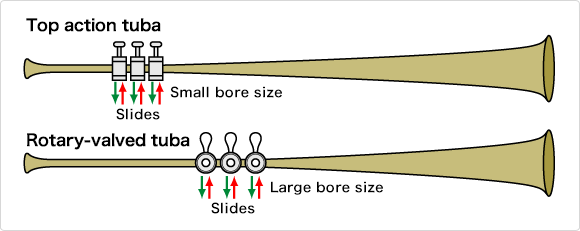The Structure of the Tuba
Is There No Relationship between Bore Size and Volume?
The bore size changes with the location of the valves
For trumpets and trombones, whose cylindrical sections comprise a large proportion of the overall instrument, the heaviness of their sound corresponds to increased bore size (tube diameter). We cannot say exactly the same, however, for the tuba.
A tuba's bore size indicates the diameter of the slides. Suppose, for example, that there were two tubas that have the same pitch, the same length of their conical sections, and the same flared bells, but one tuba is top action and the other is rotary valved. If the same musician played both of these, we would expect nearly the same volume of sound.
If these two tubas were elongated, their tubes would look as they do in the illustration. The top action valves are closer to the mouthpiece than the rotary action valves, which places the former at a narrower point along the tube. Consequently, the diameter (or bore size) of the slides is also smaller. The design dictates that the location of the slides changes with the location of the valves, and the result also affects the bore size. This means that the sound of the tuba does not necessarily get bigger when the bore size is larger.

Conceptual diagram of the valve location and the bore size
Musical Instrument Guide:Tuba Contents
Origins
Structure
How to Play
How the Instrument is Made
Choosing an Instrument
Trivia
- A Massive Tuba from 100 Years Ago
- Depending on the Country, a Baritone is Not a Baritone
- The Cinbasso-Popular in Italian Opera
- All Brass Instruments Have Marching Band Models
- Famous Musical Pieces for the Tuba (Bass)
- The Compensating System for the Euphonium
- There are Various Mutes for the Tuba
- Ease of Playing Pedal Tones
- Why Are Tubas So Expensive?
- Do Jazz Musicians Play the Tuba?
- Brass Band Songs Featuring the Tuba
- An Instrument in the Key of B♭, Yet the Music is Written in C
